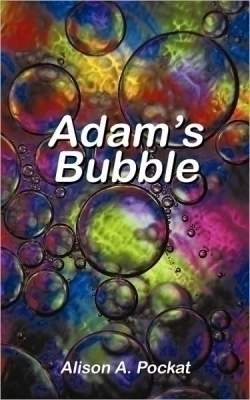Adam's Bubble
One afternoon Adam finds himself all alone and bored. He finds a tube of special, very durable bubbles that his mother had purchased for him. He learns to stick one bubble to another to form a larger bubble. Eventually, he produces a bubble that is so big he is able to fit inside of it. Once he is in his bubble the magic starts. He bounces around in the bubble, and, as he bounces, he shrinks in size until he finds himself high up in the air and no bigger than an ant. He does not know how to reverse this situation and must seek help from the creatures that live in his backyard. Over the course of the adventure he meets a variety of critters, including a fungus, a frog, an earthworm and an ant. Each of these characters tells Adam something about their lives, how they survive and how they spend their time. For example, Woody the Roach tells Adam about feeding its babies. “We eat wood and it breaks down in our gut. When the young ones are ready, we release food from our butts. We feed the young ones kind of a juice made from broken down wood. We make it ourselves in our gut. It’s highly nutritious.”
Author Alison A. Pockat is a landscape architect, and she clearly has a great deal of knowledge about the life forms that one might encounter in a back yard. This book does a good job of providing some very basic information on a variety of different animals. The facts in the book are clearly presented, and most young children in the five to eight year old range will learn something from the book.
However, the book fails on several levels. Adam and the characters he interacts with lack personality. The author has not provided the reader with any reason to care about Adam or his new animal friends. Strong characterization is very important in a book such as this. If a child is engaged and cares about the characters in the book, he or she is far more likely to absorb and remember the facts that come with it. This book is unlikely to engage the reader enough for much of anything to stick in his or her mind. What’s more, though the facts the author has presented are certainly sound, they are limited in scope. Inasmuch as this book might be a good starting point for discussing the backyard environment, it probably will not adequately answer many questions children are likely to have. There are many wonderful nonfiction books available that cover the same material with greater depth and breadth. Most readers will be more content with one of these nonfiction options.
Reviewed by
Catherine Thureson
Disclosure: This article is not an endorsement, but a review. The publisher of this book provided free copies of the book and paid a small fee to have their book reviewed by a professional reviewer. Foreword Reviews and Clarion Reviews make no guarantee that the publisher will receive a positive review. Foreword Magazine, Inc. is disclosing this in accordance with the Federal Trade Commission’s 16 CFR, Part 255.

